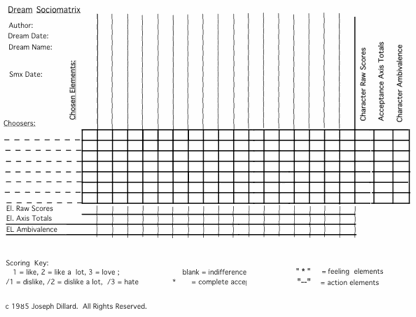
Dream Sociometry is an approach to dreamwork created by Joseph Dillard in 1981 based on the sociometric methodology developed by psychiatrist J.L. Moreno beginning in 1914. Dr. Moreno, a younger Austrian contemporary of Freud’s, is most widely recognized as the creator of psychodrama. He also developed the role playing procedures made famous by T-groups and sensitivity groups as well as by Fritz Perls and Gestalt therapy. Dream Sociometry is the foundational methodology for Integral Deep Listening.
“Dream Sociometry” means “the measurement of groups found in dreams.” It assumes that dream characters, life events, and mythic themes can be productively approached as if they are members of ad hoc intrasocial groups, or temporary, intention-based, internal social networks. The nature of these intrasocial groups is explored through a process of character identification, or structured role play. Characters are asked to score themselves regarding eight degrees of preference, “like,” “like a lot,” “love,” “dislike,” “dislike a lot,” “hate,” “don’t care,” and “no preferences.” Responses are noted numerically in a grid called a Dream Sociomatrix. Tabulations of this data can be used to form a visual presentation of the relationships of the various dream group members. This depiction is called a Dream Sociogram.
Explanatory statements accompany and elucidate preferences. Characters say why they have the preferences that they do. These are called “elaborations” and are noted in the sociomatrix commentary. In addition there are a number of other commentaries, in which characters are asked their opinions about themselves, dreams, and life issues.
Dream Sociometry has been used in the treatment of agoraphobia, anxiety disorder, depression, relationship counseling, identity disorder, PTSD, and career counseling. It has also been used to explore and gain objectivity toward waking dreams such as cultural nightmares of terrorism, war, and global warming. Dream Sociometry demonstrates that from most non-waking-based perspectives there is little meaningful difference between internal, subjective dream reality and waking “objective” reality.
Dream Sociometry is very thorough in its exploration of any particular dream. . By the time you have created the Dream Sociomatrix, associated Commentaries, and displayed the data from the Dream Sociomatrix in the Dream Sociogram, you will have examined the dream or the life situation from a number of legitimate but relatively autonomous perspectives. The result will be a broader, more inclusive perspective that transcends and includes the drama that created the experience in the first place. This is, relatively speaking, moksha, or radical freedom in relationship to the dreamer’s original perspective within the dream and of the dream upon awakening and making associations to it. Hundreds of Dream Sociomatrices were created during the 1980’s before the IDL Interviewing Protocols were developed.
Will you benefit from learning more about Dream Sociometry?
Do you want a very thorough understanding of why you had a dream?
Do you want a deeper understanding of why your dream characters interact in the ways that they do?
Would you like to interview a number of the characters in a dream at the same time?
Would you like to get in touch with the consciousness that created your dream in the first place?
Do you want to understand why types of relationships keep repeating in your life?
Do you want to understand why your “luck” isn’t better?
Would you like a better grasp of historical and world events and cultural myths?
Do you want to understand the purposes and methods behind Integral Deep Listening?
Do you want to work toward certification as a Practitioner in IntegralDeep Listening?
If you answered “yes” to more than one of these questions, you will benefit from looking deeper into this fascinating dreamwork methodology.
To learn about the Dream Sociomatrix, go here.
To view a template for the creation of a Dream Sociomatrix, Commentaries, and Dream Sociogram, go here.
For an example of a completed commentary, go here.
To learn about the Dream Sociogram, go here.
To explore an example of a completed Dream Sociogram, go here.
To explore an example of the application of Dream Sociometry to a cultural nightmare (9/11) go here.
If you choose to create one or more Dream Sociomatrices on any of your own dreams or life issues, please share your findings with us on this blog. We will be happy to answer your questions and support you in any way we can.
